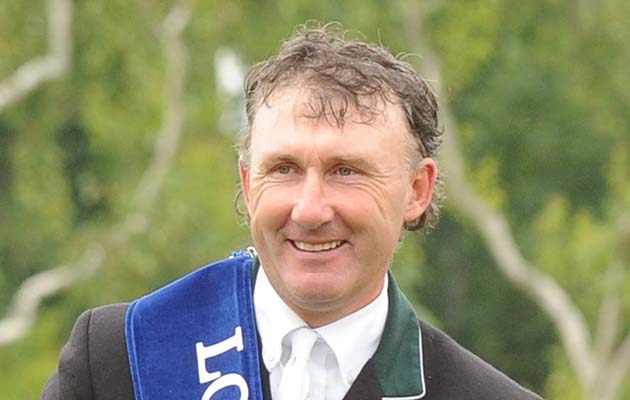In an exclusive interview with H&H’s showjumping editor Jennifer Donald, the British Showjumping chief executive responds to Nick Skelton’s recent opinion piece calling for a shake-up of showjumping in Britain...
As the nation emerges from a global pandemic, a skeleton staff at British Showjumping (BS) has made Herculean efforts to ensure the sport was one of the first to return competitively.
But in the midst of it all, an opinion piece in H&H penned by Nick Skelton put further spotlight on the sport’s governing body. The Olympic champion called for a major restructure of the sport, igniting some fierce debate among the membership, some of which we featured in H&H .
So what was the reaction of BS’s chief executive of 10 years, Iain Graham – does he believe British showjumping needs a shake-up?
{"content":"PHA+4oCcSWYgd2UgdHVybiBvdXIgbWluZHMgYmFjayB0byAyMDE0LCB3ZSB3ZXJlIGdldHRpbmcgYmxhbWVkIGZvciBzaGFraW5nIHRoZSBzcG9ydCB1cCB0b28gbXVjaCzigJ0gaGUgcmVwbGllcywgcmVmZXJyaW5nIHRvIHRoZSBpbnRyb2R1Y3Rpb24gb2YgcmVnaW9uYWwgbGVhZ3VlcyBhbmQgcmV2YW1wZWQgd2ludGVyIHNob3dzLCBhcyB3ZWxsIGFzIGEgZHJpdmUgZm9yIG1vcmUgaW50ZXJuYXRpb25hbCBzaG93cy48L3A+CjxwPuKAnENoYW5nZXMgaGF2ZSBiZWVuIG1hZGUgdGhyb3VnaCB0aGUgcGFzdCBlaWdodCB5ZWFycyB3aGlsZSBzdGlsbCBtYWludGFpbmluZyB0aGUgY291bnR5IHNob3cgY2lyY3VpdCDigJMga2VlcGluZyB0aGF0IGFzIGEgc2hvcCB3aW5kb3cgZm9yIHNob3dqdW1waW5nIHRvIHRoZSBwdWJsaWMg4oCTIGFuZCByZWNvZ25pc2luZyB0aGF0IGludGVybmF0aW9uYWxseSB0aGUgc3BvcnQgaGFzIGJhbGxvb25lZCwgd2l0aCB0aGUgR2xvYmFsIENoYW1waW9ucyBUb3VyLCBvdGhlciBzZXJpZXMgYW5kIHRvdXJzIGFuZCBuZXcgY291bnRyaWVzIGJlY29taW5nIGludm9sdmVkIGluIHRoZSBzcG9ydCB3aGljaCBtZWFucyBuZXcgbWFya2V0cyBmb3Igb3VyIGJyZWVkZXJzIGFuZCBwcm9kdWNlcnMuPC9wPgo8cD48ZGl2IGNsYXNzPSJhZC1jb250YWluZXIgYWQtY29udGFpbmVyLS1tb2JpbGUiPjxkaXYgaWQ9InBvc3QtaW5saW5lLTIiIGNsYXNzPSJpcGMtYWR2ZXJ0Ij48L2Rpdj48L2Rpdj48c2VjdGlvbiBpZD0iZW1iZWRfY29kZS0zMSIgY2xhc3M9ImhpZGRlbi1tZCBoaWRkZW4tbGcgcy1jb250YWluZXIgc3RpY2t5LWFuY2hvciBoaWRlLXdpZGdldC10aXRsZSB3aWRnZXRfZW1iZWRfY29kZSBwcmVtaXVtX2lubGluZV8yIj48c2VjdGlvbiBjbGFzcz0icy1jb250YWluZXIgbGlzdGluZy0tc2luZ2xlIGxpc3RpbmctLXNpbmdsZS1zaGFyZXRocm91Z2ggaW1hZ2UtYXNwZWN0LWxhbmRzY2FwZSBkZWZhdWx0IHNoYXJldGhyb3VnaC1hZCBzaGFyZXRocm91Z2gtYWQtaGlkZGVuIj4NCiAgPGRpdiBjbGFzcz0icy1jb250YWluZXJfX2lubmVyIj4NCiAgICA8dWw+DQogICAgICA8bGkgaWQ9Im5hdGl2ZS1jb250ZW50LW1vYmlsZSIgY2xhc3M9Imxpc3RpbmctaXRlbSI+DQogICAgICA8L2xpPg0KICAgIDwvdWw+DQogIDwvZGl2Pg0KPC9zZWN0aW9uPjwvc2VjdGlvbj48L3A+CjxwPuKAnFdlIGhhdmUgdHJpZWQgdG8gbW92ZSB3aXRoIGFsbCB0aGF0IGFuZCBpbiB0aGUgcGFzdCBmaXZlIHllYXJzIHdl4oCZdmUgYWRkZWQgQm9sZXN3b3J0aCBhbmQgTGl2ZXJwb29sLCBhbmQgd2XigJl2ZSBzZWVuIFdpbmRzb3IgZ28gdXAgdG8gZml2ZS1zdGFyIGxldmVsLOKAnSBoZSBhZGRzLiDigJxUaGVyZSBoYXMgYmVlbiBwb3NpdGl2ZSBuZXdzIGluIGFsbCBhc3BlY3RzLCBmcm9tIHRoZSBncmFzc3Jvb3RzIHdpdGggdGhlaXIgYW1hdGV1ciBjaGFtcGlvbnNoaXBzIGF0IEFpbnRyZWUsIHRoZSBuYXRpb25hbCBjaGFtcGlvbnNoaXBzIGF0IFN0b25lbGVpZ2ggUGFyayBhbmQgdGhlIHNwcmluZyBjaGFtcGlvbnNoaXBzLuKAnTwvcD4KPHA+T3BpbmlvbiBpcyBzcGxpdCBvbiBOaWNr4oCZcyBzdWdnZXN0aW9uIHRvIGZvY3VzIHNjaGVkdWxlcyBvbiBoZWlnaHQgYW5kIGFnZSBjbGFzc2VzLCBhcyBpcyB0aGUgbm9ybSB0aHJvdWdoIG11Y2ggb2YgRXVyb3BlLCBidXQgdGhlcmUgc2VlbXMgdG8gYmUgYSBzdHJvbmcgY2FsbCBmb3Igc2ltcGxpZmljYXRpb24sIG5hbWVseSByZWR1Y2luZyB0aGUgbnVtYmVyIG9mIGNsYXNzZXMuIFdvdWxkIGxvY2tkb3duIGhhdmUgcHJlc2VudGVkIGFuIG9wcG9ydHVuaXR5IHRvIGRlbGl2ZXIgc29tZXRoaW5nIG5ldz88L3A+CjxwPuKAnEkgZG9u4oCZdCB0aGluayBub3cgaXMgdGhlIHRpbWUgZm9yIGNoYW5nZSzigJ0gaGUgc3RhdGVzLiDigJxJZiB3ZSB3ZXJlIHRvIGNoYW5nZSB0aGUgc3RydWN0dXJlIG9mIHRoZSBzcG9ydCBzaWduaWZpY2FudGx5LCB3ZeKAmWQgZmlyc3RseSBuZWVkIHRvIGxvb2sgYXQgdGhlIGltcGFjdCB0aGF0IHdvdWxkIGhhdmUgb24gc2hvdyB2ZW51ZXMuPC9wPgo8ZGl2IGNsYXNzPSJhZC1jb250YWluZXIgYWQtY29udGFpbmVyLS1tb2JpbGUiPjxkaXYgaWQ9InBvc3QtaW5saW5lLTMiIGNsYXNzPSJpcGMtYWR2ZXJ0Ij48L2Rpdj48L2Rpdj4KPHA+4oCcQW55IG9yZ2FuaXNlciBjYW4gc2NoZWR1bGUgYWdlIGFuZCBoZWlnaHQgY2xhc3NlcywgYnV0IHRoZSByZWFzb24gbWFueSBkb27igJl0IGlzIHRoYXQgd2UgZG9u4oCZdCBoYXZlIGEgbGFyZ2UgbnVtYmVyIG9mIG1lbWJlcnMgcmlkaW5nIHlvdW5nIGhvcnNlcy4gSXQgbWF5IGFsc28gcmVzdHJpY3QgdGhlIG51bWJlcnMgdGhhdCB3b3VsZCBqdW1wIGluIHRob3NlIGNsYXNzZXMuPC9wPgo8cD7igJxPbmUgb2YgdGhlIGpveXMgb2YganVtcGluZyBpbiBpdHMgY3VycmVudCBmb3JtYXQgaXMgdGhhdCBwZW9wbGUgd2hvIHdvcmsgZnVsbCB0aW1lIGNhbiBjb21wZXRlIGFnYWluc3QgYW4gT2x5bXBpYyByaWRlciBvbiBhIHlvdW5nIGhvcnNlLiBUaGF0IHdvdWxkIGJlIGxvc3QgaWYgd2Ugd2VudCBpbnRvIGEgdmVyeSBkaWZmZXJlbnQgbW9kZWwgb2Ygc2VncmVnYXRpbmcgdGhlIHByb2Zlc3Npb25hbHMgcHJvZHVjaW5nIHlvdW5nIGhvcnNlcyBmcm9tIHRoZSBvdGhlciBtZW1iZXJzLuKAnTwvcD4KPGRpdiBjbGFzcz0iYWQtY29udGFpbmVyIGFkLWNvbnRhaW5lci0tbW9iaWxlIj48ZGl2IGlkPSJwb3N0LWlubGluZS00IiBjbGFzcz0iaXBjLWFkdmVydCI+PC9kaXY+PC9kaXY+CjxwPkFyZSB3ZSBzaW1wbHkgZHJhZ2dpbmcgb3VyIGZlZXQgYmVoaW5kIHRoZSByZXN0IG9mIHRoZSB3b3JsZCB3aXRoIHRoZSBjdXJyZW50IHN5c3RlbT88L3A+CjxwPuKAnEl04oCZcyBpbnRlcmVzdGluZyBiZWNhdXNlIGl0IGRlcGVuZHMgd2hvIHlvdSBzcGVhayB0byzigJ0gc2F5cyBJYWluLiDigJxTb21lIHBlb3BsZSBpbiBFdXJvcGUgdGhpbmsgdGhhdCB0aGUgQnJpdGlzaCBzeXN0ZW0gd2hlcmUgeW91IGNhbiBqdW1wIGEgaG9yc2UsIHJlZ2FyZGxlc3Mgb2YgaXRzIGFnZSwgaW4gdGhlIGNsYXNzIHRoYXTigJlzIGFwcHJvcHJpYXRlIGZvciBpdHMgYWJpbGl0eSBpcyBhIGdvb2QgdGhpbmcuPC9wPgo8ZGl2IGNsYXNzPSJhZC1jb250YWluZXIgYWQtY29udGFpbmVyLS1tb2JpbGUiPjxkaXYgaWQ9InBvc3QtaW5saW5lLTUiIGNsYXNzPSJpcGMtYWR2ZXJ0Ij48L2Rpdj48L2Rpdj4KPHA+4oCcTGV04oCZcyBub3QgZm9yZ2V0LCBhIGxvdCBvZiByaWRlcnMgd2hvIGhhdmUgaGFkIE9seW1waWMgc3VjY2VzcyBwcm9kdWNlZCB0aGVpciBob3JzZXMgdXAgdGhyb3VnaCB0aGUgQnJpdGlzaCBzeXN0ZW0uIFNvIGl04oCZcyBub3QgZHJhZ2dpbmcgb3VyIGZlZXQg4oCTIHRoZXJlIGFyZSBvdGhlciBvcHRpb25zIGFuZCBkaWZmZXJlbnQgY291bnRyaWVzIGhhdmUgcGx1c2VzIGFuZCBtaW51c2VzLuKAnTwvcD4KPGgzPk90aGVyIHdheXMgb2YgaW52ZXN0aW5nPC9oMz4KPHA+QW5vdGhlciBob3QgdG9waWMgaGFzIGJlZW4gaW5jcmVhc2luZyBpbnZlc3RtZW50IGFuZCBpbXByb3ZpbmcgZmFjaWxpdGllcyBpbiBCcml0aXNoIHNob3cgY2VudHJlcyDigJMgTmlja+KAmXMgcHJvcG9zYWwgd2FzIHRvIHJhaXNlIHRoZSBtZW1iZXJzaGlwIGZlZSB0byBmdW5kIGl0LjwvcD4KPHA+4oCcV2UgcmVjZWl2ZSBmdW5kaW5nIHRocm91Z2ggQnJpdGlzaCBFcXVlc3RyaWFuIGZyb20gVUsgU3BvcnQsIFNwb3J0IEVuZ2xhbmQgYW5kIGZyb20gU2NvdGxhbmQgYW5kIFdhbGVz4oCZIGRldm9sdmVkIGZ1bmRpbmcs4oCdIGV4cGxhaW5zIElhaW4uIOKAnFdlIGNhbiBvbmx5IGFjY2VzcyB0aGF0IGlmIHdlIHNob3cgdGhhdCB3ZSBhcmUgYWNjZXNzaWJsZSB0byBldmVyeW9uZSB0aGF0IHdhbnRzIHRvIHRha2UgcGFydCwgcmVnYXJkbGVzcyBvZiB0aGVpciBiYWNrZ3JvdW5kIG9yIGJlbGllZnMsIGFuZCBmaW5hbmNlIHNob3VsZG7igJl0IGJlIGFuIG9ic3RhY2xlIHRvIGJlaW5nIGEgbWVtYmVyIG9mIGEgZ292ZXJuaW5nIGJvZHku4oCdPC9wPgo8cD5TbyBoZSBtYXkgbm90IGFncmVlIHdpdGggTmlja+KAmXMgbWV0aG9kLCBidXQgYXJlIHRoZXJlIG90aGVyIHdheXMgb2YgaW52ZXN0aW5nPzwvcD4KPHA+4oCcVGhlcmUgd2FzIFNwb3J0IEVuZ2xhbmQgZnVuZGluZyBhdmFpbGFibGUgZm9yIGNlcnRhaW4gdmVudWVzIHRoYXQgZnVsZmlsbGVkIHRoZSBjcml0ZXJpYSB0byBiaWQgZm9yIGZ1bmRzIHRvIGhlbHAgaW1wcm92ZSB0aGVpciBmYWNpbGl0aWVzLOKAnSByZXZlYWxzIElhaW4uIOKAnEnigJltIGF3YXJlIHRoZXJlIHdlcmUgdmVudWVzIGluIHRoZSBwYXN0IGZpdmUgeWVhcnMgd2hvIG1hZGUgc3VjY2Vzc2Z1bCBhcHBsaWNhdGlvbnMgdG8gaGVscCB3aXRoIHNwZWNpZmljIHByb2plY3RzLjwvcD4KPHA+4oCcV2hhdCBCUyBjYW7igJl0IGRvIGlzIHVzZSBtZW1iZXJz4oCZIG1vbmV5IHRvIGludmVzdCBpbiBhIHByaXZhdGVseSBvd25lZCBmYWNpbGl0eSBiZWNhdXNlIHRoZSBpbXByb3ZlbWVudHMgdG8gdGhhdCBmYWNpbGl0eSB0aGVuIHNpdCB3aXRoIHRoZSBvd25lciwgZXZlbiBpZiB0aGV5IGJlbmVmaXQgdGhlIG1lbWJlcnMuIE1hbnkgdmVudWVzIGFyZSBhbHNvIHVzZWQgYnkgb3RoZXIgb3JnYW5pc2F0aW9ucywgd2hvIHdvdWxkIGFsbCBiZW5lZml0IGZyb20gd2hhdGV2ZXIgaW1wcm92ZW1lbnQgaGFkIGJlZW4gZG9uZS48L3A+CjxwPuKAnEJ1dCB3ZSBhcmUgdmVyeSBhd2FyZSBvZiB0aGUgaW5jcmVhc2luZyBjb3N0cyB0byBhbGwgdmVudWVzLCB3aGV0aGVyIHRoYXQgYmUgdGhyb3VnaCBzdGFmZmluZywgbWFpbnRlbmFuY2Ugb3IgaGVhbHRoIGFuZCBzYWZldHkgcmVxdWlyZW1lbnRzLCBhbmQgdGhhdOKAmXMgd2h5IHdlIGhhdmVu4oCZdCBpbmNyZWFzZWQgdGhlIHNob3cgYWZmaWxpYXRpb24gZmVlIHNpbmNlIDIwMTAu4oCdPC9wPgo8cD5XaXRoIHZlbnVlcyBvbiB0aGUgQ29udGluZW50IGJlbmVmaXRpbmcgZnJvbSByYXRlIHJlbGllZiwgb25lIHJpZGVyIGFza2VkIHdoeSBubyBvbmUgaGFzIGJlZW4gbG9iYnlpbmcgZm9yIGEgcmVkdWN0aW9uIGluIFVLIGJ1c2luZXNzIHJhdGVzLCB3aGljaCBhcmUgYSBtYXNzaXZlIGJ1cmRlbiBvbiB2ZW51ZXMuPC9wPgo8cD7igJxXZSBoYXZlIGRvbmUgd29yayBvbiB0aGlzLiBDZXJ0YWlubHkgdHdpY2UgaW4gbXkgdGltZSBhcyBjaGllZiBleGVjdXRpdmUgb2Ygc2hvd2p1bXBpbmcgdGhlcmXigJlzIGJlZW4gYSBjb25jZXJ0ZWQgZWZmb3J0LOKAnSBzYXlzIElhaW4uIOKAnExhdHRlcmx5IHRoZSBlZmZvcnQgd2FzIGxlZCBieSB0aGUgQnJpdGlzaCBIb3JzZSBTb2NpZXR5IG9uIGJlaGFsZiBvZiBlcXVlc3RyaWFuIGNlbnRyZXMsIHdoaWNoIGluY2x1ZGVkIHJpZGluZyBzY2hvb2xzIGFuZCBjb21wZXRpdGlvbiB2ZW51ZXMuIFVuZm9ydHVuYXRlbHkgdGhlIEdvdmVybm1lbnQgYXQgdGhhdCBwb2ludCB3YXMgdHJ5aW5nIHRvIHJlZHVjZSB0aGUgZGVmaWNpdCBhbmQgdGhleSBzYWlkIHRoZXJlIHdvdWxkIGJlIG5vIHJlZHVjdGlvbiBpbiBtb25leSB0aGF0IHRoZXkgd2VyZSByZWNlaXZpbmcgZnJvbSBidXNpbmVzcyByYXRlcyBmcm9tIHNwb3J0aW5nIHZlbnVlcy48L3A+CjxwPuKAnFdoaWxlIEkgYXBwcmVjaWF0ZSB0aGF0IHZlbnVlcyBhcmUgc3VmZmVyaW5nIGF0IHRoaXMgcG9pbnQsIEkgaGF2ZSBhIGZlZWxpbmcgdGhhdCBhcyB3ZSBjb21lIG91dCBvZiBsb2NrZG93biwgdGhlIEdvdmVybm1lbnQgd2lsbCBhZ2FpbiBiZSBsb29raW5nIGF0IHdheXMgb2YgcmVkdWNpbmcgdGhlIGRlZmljaXQgY2F1c2VkIGJ5IHRoZSB2aXJ1cy4gQnV0IHdlIHdpbGwgZXhwbG9yZSBhbGwgb3Bwb3J0dW5pdGllcy7igJ08L3A+CjxoMz5BIGdsb2JhbCBzcG9ydDwvaDM+CjxwPldlIGdvIG9uIHRvIGRpc2N1c3MgdGhlIG1hc3MgZXhvZHVzIG9mIHJpZGVycyBvdmVyc2VhcywgcGFydGljdWxhcmx5IGR1cmluZyB0aGUgd2ludGVyIG1vbnRocy48L3A+CjxwPuKAnFdoYXQgd2UgZG9u4oCZdCBoYXZlIGlzIHRoZSBTZW50b3dlciBQYXJrcyBhbmQgVmlsYW1vdXJhcyzigJ0gc2F5cyBJYWluIG9mIHRoZSBlbnZpYWJsZSBlcXVlc3RyaWFuIHZlbnVlcyBhY3Jvc3MgRXVyb3BlLjwvcD4KPHA+4oCcQnV0IHdl4oCZcmUgYWxzbyBub3QgdGhlIG9ubHkgY291bnRyeSB0aGF0IGV4cGVyaWVuY2VzIGFuIGV4b2R1cyBvZiByaWRlcnMgdG8gU3BhaW4gYW5kIFBvcnR1Z2FsLjwvcD4KPHA+4oCcVGhlIHNwb3J0IGhhcyBiZWNvbWUgZ2xvYmFsIOKAkyBJIGRvbuKAmXQgdGhpbmsgd2UgY2FuIGZpZ2h0IHRoYXQg4oCTIHNvIHdlIG5lZWQgdG8gbWFrZSBzdXJlIHRoYXQgd2hhdCB3ZSBkZWxpdmVyIGluIEJyaXRhaW4gaXMgb2YgYSBzdGFuZGFyZCB0aGF0IGlzIHdvcnRoIHRoZSBwZW9wbGUgYXQgaG9tZSB0YWtpbmcgdGhlaXIgaG9yc2VzIHRvLiBUaGF04oCZcyBzb21ldGhpbmcgd2UgbmVlZCB0byB3b3JrIG9uIGFzIHdlbGwg4oCTIHRvIGJlIGEgcGxhY2UgdGhhdCBwZW9wbGUgd2FudCB0byBjb21lIGFuZCBiYXNlIHRoZW1zZWx2ZXMuPC9wPgo8cD7igJxXZSBoYXZlIHNlZW4gYW4gaW5jcmVhc2UgaW4gdGhlIHBhc3QgeWVhciBvciB0d28gaW4gdGhlIG51bWJlcnMgYXQgb3VyIHdpbnRlciBzaG93cyDigJMgYW5kIHdobyBrbm93cyB3aGF0IHRoZSB0cmF2ZWwgcmVzdHJpY3Rpb25zIG1heSBiZSBwb3N0LUJyZXhpdC4gTW9yZSBwZW9wbGUgbWF5IGNob29zZSB0byBzdGF5IGluIEJyaXRhaW4u4oCdPC9wPgo8cD5Bbm90aGVyIHJlYXNvbiByaWRlcnMgY2l0ZSBmb3IgY29tcGV0aW5nIGFicm9hZCBpcyB0byBqdW1wIGJldHRlciBxdWFsaXR5IG9mIHRyYWNrcywgZXNwZWNpYWxseSBmb3IgeW91bmdlciBob3JzZXMuPC9wPgo8cD7igJxXZeKAmXZlIGJlZW4gd29ya2luZyB3aXRoIG90aGVyIGZlZGVyYXRpb25zIHRvIGludml0ZSBjb3Vyc2UtZGVzaWduZXJzIGhlcmUs4oCdIGhlIGV4cGxhaW5zLiDigJxFcXVhbGx5IHdl4oCZcmUgaW5jcmVhc2luZyB0aGUgbnVtYmVyIG9mIGNvdXJzZS1kZXNpZ25lcnMgd2hvIGhhdmUgRkVJIHF1YWxpZmljYXRpb25zIGFuZCB0aGF0IHJlcXVpcmVzIHRoZW0gdG8gZ28gYWJyb2FkIGFuZCBnYWluIGV4cGVyaWVuY2UgYW5kIHdvcmsgd2l0aCBvdGhlciBjb3Vyc2UtZGVzaWduZXJzLiBJdOKAmXMgYW4gb25nb2luZyBwaWVjZSBvZiB3b3JrLuKAnTwvcD4KPHA+T3ZlcmFsbCwgaXQgYXBwZWFycyB0aGF0IHJpZGVycyBqdW1waW5nIGF0IHRoZSBsb3dlciBsZXZlbHMgc2VlbSBmYWlybHkgY29udGVudCB3aXRoIHRoZSBjdXJyZW50IHN5c3RlbSDigJMgaGF2ZSB0aGUgaW1wcm92ZW1lbnRzIGluIHRoYXQgYXJlYSBjb21lIGF0IHRoZSBleHBlbnNlIG9mIHRob3NlIGhpZ2hlciB1cCB0aGUgbGFkZGVyPzwvcD4KPHA+4oCcSeKAmWQgc2F5IHRob3NlIGZpbmRpbmcgaXQgbW9zdCBkaWZmaWN1bHQgbm93IGFyZSBvdXIgMS4yMG0gdG8gMS40NW0gcHJvZHVjZXJzIG9yIG5hdGlvbmFsIHJpZGVycyB0cnlpbmcgdG8gZWFybiBhIGxpdmluZyBmcm9tIHRoZSBzcG9ydCBpbiB0aGF0IHNlY3RvcizigJ0gc2F5cyBJYWluLjwvcD4KPHA+4oCcQWJvdmUgdGhhdCBsZXZlbCwgdGhlcmXigJlzIHRoZSBjaGFsbGVuZ2Ugb2YgZ2V0dGluZyBpbnRvIHNob3dzLCBidXQgYWN0dWFsbHkgdGhlcmUgaXMgc3BvbnNvcnNoaXAgYW5kIHByaXplLW1vbmV5LCB0aGVyZSBpcyBhIG1vZGVsIHRoZXJlIG9mIGJlaW5nIGFibGUgdG8gYnJpbmcgaG9yc2VzIG9uIGFuZCBzZWxsIHRoZW0sIG9yIGRvIGEgYml0IG9mIHRlYWNoaW5nLCBhbmQgdGhleSBtYW5hZ2UgdG8gbWFrZSBpdCB3b3JrLjwvcD4KPHA+4oCcU28gSSBhbHdheXMgc2F5IHRoZSBsb3dlciBlbmQgaXMgT0sg4oCTIGFzIGxvbmcgYXMgd2UgYXJlIGFjY2Vzc2libGUgdG8gdGhlbSBhbmQgZ2l2ZSB0aGVtIG5pY2Ugc2hvd3MgdGhhdCBhcmUgbm90IHRvbyBmYXIgYXdheSBhbmQgdGhlIG9jY2FzaW9uYWwgY2hhbXBpb25zaGlwLCB0aGF0IGtlZXBzIHRoZW0gaGFwcHkuIEl04oCZcyB0aGUgb3RoZXIgZ3JvdXAgd2hlcmUgYW55IHNtYWxsIGNoYW5nZSBjYW4gcmVhbGx5IGFmZmVjdCB0aGVpciBidXNpbmVzcy48L3A+CjxwPuKAnFRoZW4gYXQgdGhlIGhpZ2hlciBsZXZlbCwgSSByZWd1bGFybHkgbWVldCBvdXIgaW50ZXJuYXRpb25hbCBzaG93IG9yZ2FuaXNlcnMgYXQgZm9yZWlnbiBzaG93cyBhbmQgRkVJIG1lZXRpbmdzLCB3aGVyZSB3ZeKAmXJlIGFsbCB3b3JraW5nIHRvZ2V0aGVyIHRvIHRyeSB0byBoZWxwIG1vdmUgdGhlIHNwb3J0IGZvcndhcmRzIGludGVybmF0aW9uYWxseS7igJ08L3A+CjxwPldpdGggc3VjaCBhbiBvdXRwb3VyaW5nIG9mIG9waW5pb24gb24gc29jaWFsIG1lZGlhIGluIHJlc3BvbnNlIHRvIE5pY2vigJlzIHBpZWNlLCBhcmUgbWVtYmVycyBiZWluZyBoZWFyZD88L3A+CjxwPuKAnFdl4oCZcmUgYWx3YXlzIGxvb2tpbmcgYXQgd2hhdCB3ZSBjYW4gZG8sIGFuZCB0aGUgc3RydWN0dXJlIHdlIGhhdmUgbm93IHdpdGggdGhlIGJvYXJkLCB0aGUgbmF0aW9uYWwgc3BvcnQgY29tbWl0dGVlLCB0aGUgcGVyZm9ybWFuY2UgY29tbWl0dGVlIGFuZCB0aGUgbWVtYmVycyBjb3VuY2lsIG1lYW5zIHRoZXJlIGFyZSByb3V0ZXMgZm9yIG1lbWJlcnMgdG8gY29tZSB3aXRoIHN1Z2dlc3Rpb25zIOKAkyBhbmQgdGhleSByZWd1bGFybHkgZG8s4oCdIHNheXMgSWFpbi4g4oCcTm90IGFsbCBvZiB0aGVtIGNhbiBiZSB0YWtlbiBmb3J3YXJkLCBidXQgYWxsIGFyZSBsb29rZWQgYXQuIEEgbG90IG9mIHRoZSBjaGFuZ2VzIHRoYXQgaGF2ZSB0YWtlbiBwbGFjZSBoYXZlIGNvbWUgdGhyb3VnaCB0aG9zZSBjaGFubmVscy48L3A+CjxkaXYgY2xhc3M9ImluamVjdGlvbiI+PC9kaXY+CjxwPuKAnEkgdGhpbmsgaW4gdGhlIHBhc3QgZmV3IHllYXJzIHdlIGhhdmUgc2VlbiBzaG93anVtcGluZyBpbiBCcml0YWluIHN0ZXAgdXAgYXQgYWxsIGxldmVscyzigJ0gaGUgY29uY2x1ZGVzLiDigJxNeSBob3BlIGZvciBuZXh0IHllYXIgaXMgdGhhdCB3ZSBhcmUgbm90IGluIGEgYmlnIHJlY2Vzc2lvbiBhbmQgdGhhdCB3ZSBhcmUgYWxsIG91dCBlbmpveWluZyB0aGUgc3BvcnQgYW5kIG91ciBob3JzZXMgaW4gdGhlIHdheSB0aGF0IHdlIHdlcmUgcHJpb3IgdG8gbG9ja2Rvd24u4oCdPC9wPgo8cD48ZW0+UmVmIEhvcnNlICZhbXA7IEhvdW5kOyAyIEp1bHkgMjAyMDwvZW0+PC9wPgo8cD4K"}
Are we dragging our heels behind Europe? Are we in fact the envy of the world? Let us know your thoughts at hhletters@futurenet.com
You may also be interested in…
Credit: Charles Sainsbury-Plaice
H&H’s showjumping columnist proposes how to give British showjumping a massive shake-up
H&H’s showjumping columnist reflects on the surge of support to improve the sport in Britain
The commentator and broadcaster gives his insight on how to return the sport to our screens
The plan is to run as many championship finals as is possible this year
Holly Smith and Hearts Destiny at the 2019 FEI Longines European Jumping Championships in Rotterdam.
Credit: Peter Nixon
H&H showjumping editor
Jennifer is passionate at showjumping and her role as H&H’s showjumping editor has taken her around the world reporting from shows and interviewing riders, connections and those involved behind the scenes. Since joining H&H from BBC Sport in 2005, she has written on every subject across the equestrian sphere — from turnout rugs to stable management — and has interviewed gold medallists, world champions and winners galore. She also has first-hand experience of working in the equestrian industry as a riding instructor and yard manager.






